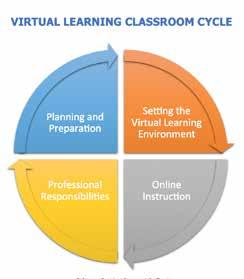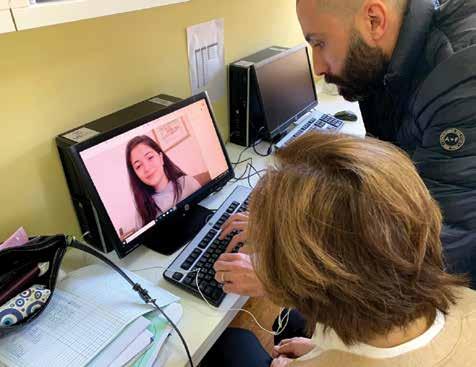
5 minute read
The Face-Off: IC Vs. COVID-19
Technically, COVID-19 should have caused some kind of mayhem at school. But the truth is, it didn’t. On February 29th, the Lebanese government asked all schools and universities to close.
That was on a Friday. On Tuesday, IC was almost fully operational - online. Teachers and students automatically took their places across their computers. It was school as usual.
Ironically, it is thanks to the October revolution, which allowed the school such a smooth transition. Only a few days into the revolution, Mahmud Shihab, the Director of the Educational Resources Center and IT, quickly implemented the Virtual Learning Environment (VLE) – which had been in the works for several years now. Maybe it was some kind of premonition on his part, but Shihab had been training teachers – current and incoming – in using the latest web tools.
As the once Educational Technology Program Administrator at IC, Shihab began lobbying for the integration of IT in the classrooms over ten years ago when he recognized that incoming younger students were digital natives – children who had never heard of a world without internet. His first challenge was training hundreds of technologically “old” teachers in both Ras Beirut and Ain Aar (“old” defined as anyone born in the pre-internet era or, in other words, over the age of 20) to use the latest web tools. In 2010, Shihab introduced Moodle (Modular ObjectOriented Dynamic Learning Environment - a high end learning management software system that produces internetbased courses and websites). It was the first step in creating a collaborative learning environment at IC and has proved to be highly effective during the school’s sudden emergency closures during the next few years. In 2017, Shihab took it one step further and introduced google classroom or G Suite. Then and now, G Suite and Microsoft Office 365, provide the single backbone sign-on system for all the school platforms with just one username and password and allows the access of thousands of websites that support Google or Microsoft sign-on systems.
Students only need their mobile phones to stay connected with their teachers.
And so it was that when both the October revolution and COVID-19 forced the closure of schools, teachers and students automatically took their places behind their screens.
But as Shihab recognized, even those measures are quickly becoming somewhat redundant.
“A new world is being shaped very fast,” he said, “we have to be ready.”
Simply put, ‘being ready’ means the ability to transition at a moment’s notice from face-to-face schooling to a 100% online mode. In a 26-page report submitted to the IC Board, Shihab outlined in painstaking details a K-12 Virtual Learning Framework that he designed (mostly based on Koehler
EDUCATIONAL TECHNOLOGY PLATFORMS
Academic Management Systems
Inspired by the Danielson Framework for Teaching which IC recently adopted, Shihab went a step further and created a Virtual Learning Classroom Cycle. Both his models have been presented to the Lebanese Ministry of Education and the Center for Educational Research and Development (CERD) charged with modernizing and developing the Lebanese curriculum.
Devised by Shihab, the K-12 Virtual School Plan builds on Koehler and Mishra’s TPACK Framework as well as Shulman’s idea of Pedagogical Content Knowledge with an emphasis on alternative assessment strategies, student support services, parents’ support, and community support. The student is the central factor that determines the technology used, choice of essential content, teaching methodologies, and assessment practices.
and Mishra’s TPACK Framework and Shulman’s idea of Pedagogical Content Knowledge) which covers essential academic and non-academic school functions including technology platforms, devices, teaching strategies, roles and responsibilities, training needs, assessments, and communication protocols supporting hybrid or full virtual learning in the school community. Inspired by the Danielson Framework for Teaching, which IC recently adopted, Shihab went a step further and created a Virtual Learning Classroom Cycle emphasizing the planning and delivery of teaching which includes: Planning and Preparation, Setting the Virtual Learning Environment, Online Instruction, and Professional Responsibilities (see graphs).
Both his models have been presented to the Lebanese Ministry of Education and the Center for Educational Research and Development (CERD) charged with modernizing and developing the Lebanese curriculum. Virtual learning, he explained is a balancing act between Synchronous (happening live and collaboratively, in which all participants are connected at the same time) and Asynchronous (happening at any time, in which lessons, videos, and assignments are posted ahead of time for a later response or discussion).
On their part, administrators and staff would run the school online through live conferencing with Google suite tailored to both academic and non-academic personnel. (IC had already started moving all non-academic platforms to the cloud to ensure full functionality of systems in times


of disaster or emergency school closures.)
Still, it is the parents and students who need to give the final nod of approval. Towards the end of May, a survey was conducted to assess parental feedback to the current virtual classroom environment, and Shihab was thrilled to note that the response was mostly positive. “Nothing will ever take the place of face to face learning,” said Shihab. “But we have to adjust to a new reality. The world of education has changed quickly and drastically. IC is keeping up, yes, but we want to be one step ahead. Students don’t have to live with the fear that they may have to repeat the year if classes are suddenly suspended.”
He should know. Shihab himself lived with this fear growing up during the vicious 16-year Lebanese civil war. In a world where WiFi did not even exist yet, it was up to him to figure out how to solve homework packets prepared by teachers. At times, there were no packets at all. He had to somehow ‘catch up’ with baffling lessons on his own.
“I remember always being worried that I would have to repeat a year or even two because I couldn’t get to class and I wouldn’t be able to teach myself at home,” he said.
It was this relentless anxiety that served as an impetus to create the Virtual Learning Plan. “IC students will never need to have such a worry,” he said. “We will face COVID-19, crises or whatever else comes our way. Learning will continue.”










